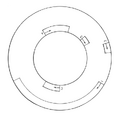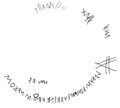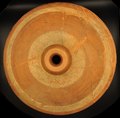VB·3.4
| Inscription | |
|---|---|
| Reading in transliteration: | tu?? |
| Reading in original script: | ?? |
| Variant reading: | tuni |
|
| |
| Object: | VB·3 Ornavasso (bottle) (Inscriptions: VB·3.1, VB·3.2, VB·3.3, VB·3.4, VB·3.5) |
| Position: | shoulder, outside |
| Orientation: | 0° |
| Direction of writing: | sinistroverse |
| Script: | North Italic script (Lepontic alphabet) |
| Letter height: | 0.5–0.8 cm0.197 in <br />0.315 in <br /> |
| Number of letters: | 4 |
| Number of words: | 1 |
| Number of lines: | 1 |
| Workmanship: | scratched after firing |
| Condition: | complete, damaged |
|
| |
| Archaeological culture: | La Tène D [from object] |
| Date of inscription: | first half of 1st c. BC [from object] |
|
| |
| Type: | unknown |
| Language: | perhaps Celtic |
| Meaning: | unknown |
|
| |
| Alternative sigla: | Whatmough 1933 (PID): 304 Tibiletti Bruno 1981: 10 Solinas 1995: 128 5 Morandi 2004: 48 B3 |
|
| |
| Sources: | Morandi 2004: 550–552 no. 48 B3 |
Images
Commentary
First published in Bianchetti 1895: 69 f. (no. 21). Examined for LexLep on 20th April 2024.
Images in Lejeune 1987: pl. XIIIc (photo = Solinas 1995: tav. LXXIb), Morandi 2004: 566, fig. 12.48 (drawing).
Inscribed a few centimetres after VB·3.3, below the innermost of the white bands (length 2 cm). ![]() and
and ![]() are preserved completely on two fragments, but the two following letters are damaged by a break and lacuna, leaving only two hastae. The confidence with which Bianchetti read tuni begs the question whether another fragment has been lost since the excavation, or whether the fragment with tu? was better preserved. tuni is given by all later scholars, some of whom saw the document (Kretschmer 1905: 99, no. 21, Rhŷs 1913: 62, no. 20 (b), Whatmough 1933: 111–113, no. 304 (d), Pisani 1964: 286 f., no. 124 (d), Lejeune 1987: 497, Tibiletti Bruno 1978: 144–146, Tibiletti Bruno 1981: 162–164, no. 10, Morandi 2004: 550–552 no. 48 B1 expressly on the basis of previous authors); the only one to reflect the damage is Solinas 1995: 375, no. 128 2, who transliterates tu[. Another point of uncertainty concerns the two dots after the last letter, which are reflected as a separator by Bianchetti and all following authors except Morandi and Solinas. While the two marks are quite clear, the look much like other spots of surface damage. The wobbly execution of upsilon is reminiscent of that of the second letter in VB·3.3.
are preserved completely on two fragments, but the two following letters are damaged by a break and lacuna, leaving only two hastae. The confidence with which Bianchetti read tuni begs the question whether another fragment has been lost since the excavation, or whether the fragment with tu? was better preserved. tuni is given by all later scholars, some of whom saw the document (Kretschmer 1905: 99, no. 21, Rhŷs 1913: 62, no. 20 (b), Whatmough 1933: 111–113, no. 304 (d), Pisani 1964: 286 f., no. 124 (d), Lejeune 1987: 497, Tibiletti Bruno 1978: 144–146, Tibiletti Bruno 1981: 162–164, no. 10, Morandi 2004: 550–552 no. 48 B1 expressly on the basis of previous authors); the only one to reflect the damage is Solinas 1995: 375, no. 128 2, who transliterates tu[. Another point of uncertainty concerns the two dots after the last letter, which are reflected as a separator by Bianchetti and all following authors except Morandi and Solinas. While the two marks are quite clear, the look much like other spots of surface damage. The wobbly execution of upsilon is reminiscent of that of the second letter in VB·3.3.
Pisani 1964: 286 f., no. 124 (b), who seems to have worked with Whatmough's inaccurate drawing of the inscriptions' placement on the flask, considered the four short inscriptions on the vase to form a sentence etninou.ealutou:iutuni:, separated for aesthetic reasons. Rather more plausible is Rhŷs' and Lejeune's (1987: 497) assumption that all the sequences are abbreviations of personal names; Morandi 1999: 172, no. 17 suggests that they record the names of the gift givers ("sottoscrizioni" in 2004: 552). The sequence, whether tuni or similar, may well be an abbreviation of a personal name; a genitive is rather unlikely in this context; see further on the word page.
See also Giussani 1902: 55 f., Piana Agostinetti 1972: 272, no. 12, tav. XXXI.12, Piana Agostinetti 1997–1999 II: 57, in IV Morandi 1999b: 308–312, no. 4.
Bibliography
| Bianchetti 1895 | Enrico Bianchetti, I sepolcreti di Ornavasso [= Atti della Società di Archeologia e Belle Arti della provincia di Torino 6], Torino: Paravia 1895. |
|---|---|
| Caramella & De Giuli 1993 | Pierangelo Caramella, Alberto De Giuli, Archeologia dell'Alto Novarese, Mergozzo: Antiquarium Mergozzo 1993. |




